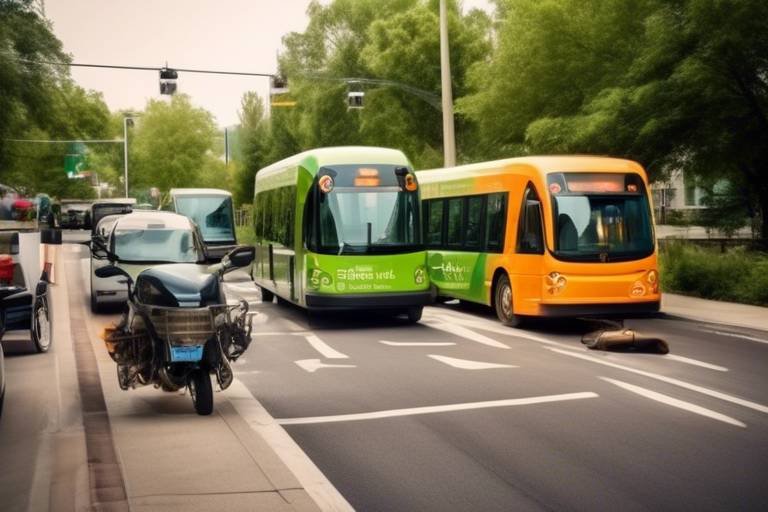How to Build a Sustainable Vacation Itinerary
Planning a sustainable vacation itinerary involves more than just choosing destinations and booking accommodations. It's about making conscious choices that minimize your environmental impact while maximizing your enjoyment and cultural experiences. By following a few simple tips and tricks, you can create a travel plan that not only benefits the planet but also enriches your journey.
When researching eco-friendly destinations, look for places that prioritize sustainability. Opt for eco-lodges nestled in the heart of nature, national parks teeming with wildlife, or green cities leading the way in environmental initiatives. Supporting these destinations helps fund local conservation efforts and ensures that future generations can also enjoy these natural wonders.
One of the easiest ways to reduce your carbon footprint while traveling is to use public transportation. Instead of renting a car or taking taxis everywhere, consider hopping on buses, trains, or bicycles to explore your destination. Not only does this help lower carbon emissions, but it also supports local transportation systems and gives you a chance to immerse yourself in the local culture.
Food plays a significant role in sustainable travel. To eat local and sustainable, indulge in regional cuisine made from locally sourced ingredients. By dining at restaurants that support small-scale farmers and producers, you not only enjoy fresh and authentic flavors but also contribute to reducing your carbon footprint.
Choosing eco-friendly accommodations is essential for a sustainable itinerary. Opt for hotels, guesthouses, or homestays that implement green practices such as recycling, energy conservation, and water-saving initiatives. Staying at these eco-conscious establishments not only minimizes your environmental impact but also supports businesses that prioritize sustainability.
Engaging in responsible tourism activities is a meaningful way to give back to the places you visit. Consider participating in wildlife conservation projects, beach cleanups, or community-based tourism initiatives. By actively contributing to local conservation efforts and community development, you can leave a positive impact on the destinations you explore.
Single-use plastic is a major environmental concern, especially in the travel industry. To reduce plastic waste during your trip, carry a reusable water bottle, shopping bag, and utensils. By avoiding single-use plastic items, you help protect the environment from pollution and promote sustainable travel practices.
Respecting local customs and traditions is crucial when traveling sustainably. Take the time to learn about the cultural norms of your destination and show respect for local traditions. By engaging with the local community in a respectful manner, you promote mutual understanding and contribute to preserving the cultural heritage of the places you visit.
Offsetting your carbon footprint is a proactive step towards neutralizing the environmental impact of your travels. Calculate the carbon emissions generated by your trip and consider supporting carbon offset projects or tree planting initiatives. By offsetting your carbon footprint, you can help mitigate the effects of climate change and contribute to a more sustainable future for the planet.

Research Eco-Friendly Destinations
Tips and tricks for creating a travel plan that minimizes environmental impact while maximizing enjoyment and cultural experiences.
When planning your next getaway, consider exploring destinations that prioritize sustainability. Opt for eco-lodges nestled in the heart of nature, national parks teeming with wildlife, or green cities leading the way in environmental initiatives. By choosing these eco-friendly destinations, you not only support local conservation efforts but also immerse yourself in the beauty of nature while treading lightly on the planet.

Use Public Transportation
Tips and tricks for creating a travel plan that minimizes environmental impact while maximizing enjoyment and cultural experiences.
When it comes to exploring a new destination, opting for public transportation can significantly reduce your carbon footprint while immersing you in the local culture. Instead of relying on private vehicles, consider taking buses, trains, or bicycles to navigate around the city or countryside.
Public transportation not only helps in reducing greenhouse gas emissions but also supports the local transportation infrastructure. By using buses or trains, you contribute to the efficiency of public transit systems and help reduce traffic congestion in popular tourist areas.
Imagine the scenic views you can enjoy from a train window or the vibrant street life you can experience while riding a local bus. Using public transportation adds an element of adventure to your journey, allowing you to interact with locals and discover hidden gems off the beaten path.
Moreover, cycling through a city or countryside not only promotes sustainability but also provides a unique perspective on the destination. You can pedal through charming neighborhoods, stop at local cafes, and feel the pulse of the city in a way that's impossible from inside a car.
By choosing public transportation, you not only reduce your environmental impact but also contribute to the local economy and community. So, next time you plan your vacation itinerary, consider incorporating public transportation for a more sustainable and enriching travel experience.
Have more questions about sustainable travel planning? Check out our FAQs below:
- How can I find eco-friendly accommodations? - Look for certifications like Green Key or LEED, read reviews from sustainable travel websites, and directly inquire about the hotel's environmental practices.
- What are some easy ways to reduce single-use plastic while traveling? - Carry a reusable water bottle, utensils, and shopping bag, avoid plastic-wrapped items, and support businesses that offer sustainable alternatives.
- How can I support local communities during my travels? - Engage in cultural activities, buy souvenirs from local artisans, dine at family-owned restaurants, and respect the customs and traditions of the destination.
- Is carbon offsetting an effective way to mitigate the environmental impact of travel? - Carbon offsetting can help neutralize the emissions from your trip by investing in projects that reduce greenhouse gases, such as renewable energy or reforestation initiatives.

Eat Local and Sustainable
When traveling, one of the best ways to immerse yourself in the local culture and support sustainability is through your food choices. By eating local and sustainable, you not only reduce your carbon footprint but also contribute to the livelihood of small-scale farmers and producers.
Imagine strolling through a bustling market filled with colorful fruits, fragrant spices, and freshly baked bread. The experience of sampling regional cuisine made from locally sourced ingredients is not only a treat for your taste buds but also a way to support the community you are visiting.
Local dishes often reflect the unique flavors and traditions of a region, offering a culinary journey that is both delicious and culturally enriching. From street food stalls to family-run restaurants, exploring the local food scene can be a memorable part of your travel experience.
By choosing to eat sustainably, you can also help reduce the environmental impact of your meals. Opting for organic and seasonal produce supports farming practices that are better for the planet, as they often involve fewer chemicals and less energy-intensive methods.
Additionally, dining at restaurants that prioritize food waste reduction and recycling can further contribute to sustainability efforts. Many establishments now focus on minimizing food waste and using eco-friendly packaging, allowing you to enjoy your meal guilt-free.
When planning your meals, consider visiting farmers' markets or farm-to-table restaurants that promote local sourcing and seasonal menus. This not only supports the local economy but also gives you a taste of the freshest ingredients the region has to offer.
Remember, every bite you take can make a difference in promoting environmental responsibility and sustainable tourism. So, savor the flavors of the destination while also contributing to a greener and more ethical travel experience.

Choose Eco-Friendly Accommodations
When it comes to choosing accommodations for your sustainable vacation, opting for eco-friendly options can make a significant difference in reducing your environmental impact. By staying in eco-conscious hotels, guesthouses, or homestays that prioritize green practices, you not only contribute to conservation efforts but also enhance your overall travel experience.
These eco-friendly accommodations often implement a range of initiatives to minimize their environmental footprint. From recycling programs and energy conservation measures to water-saving practices and sustainable building materials, these establishments go the extra mile to ensure that your stay is not only comfortable but also eco-conscious.
By choosing to stay in eco-friendly accommodations, you support the local economy and community by directly contributing to businesses that prioritize sustainability. These establishments often source their food and amenities locally, further reducing the carbon footprint of your stay and supporting small-scale farmers and producers in the area.
Moreover, eco-friendly accommodations provide an opportunity for you to immerse yourself in the local culture and environment. Many of these establishments are located in scenic or culturally rich areas, allowing you to connect more deeply with your surroundings and appreciate the beauty of your destination in a sustainable way.
When booking your stay, look for certifications or eco-labels that indicate the accommodation's commitment to sustainability. Certifications such as LEED (Leadership in Energy and Environmental Design) or Green Key can help you identify establishments that meet high environmental standards and prioritize eco-friendly practices.
Overall, choosing eco-friendly accommodations is not just about where you sleep during your travels; it's about making a conscious choice to support sustainable tourism and leave a positive impact on the places you visit. By staying in eco-conscious establishments, you can enjoy a more enriching and environmentally friendly travel experience that aligns with your values and commitment to responsible travel.

Engage in Responsible Tourism Activities
Engaging in responsible tourism activities goes beyond just sightseeing; it involves actively contributing to the well-being of the places you visit. By participating in wildlife conservation projects, beach cleanups, or community-based tourism initiatives, you can leave a positive impact on the environment and local communities. Imagine spending a day helping to protect sea turtle nests or volunteering at a local school to support education in the area. These experiences not only enrich your trip but also create lasting benefits for the destinations you explore.
When you engage in responsible tourism activities, you become a steward of the environment and a supporter of local initiatives. It's like becoming a guest in someone's home and treating it with care and respect. By immersing yourself in the culture and actively participating in conservation efforts, you become part of the solution rather than just a spectator. It's about forming connections with the places you visit and leaving them better than you found them.
One way to enhance your responsible tourism experience is by learning about the local ecosystem and the challenges it faces. Understanding the threats to wildlife, marine life, or natural habitats can inspire you to take action and make a difference during your travels. Whether it's planting trees, monitoring endangered species, or supporting sustainable farming practices, your involvement can create a ripple effect of positive change in the destination.
Moreover, responsible tourism activities offer a unique opportunity to interact with local communities and learn from their traditions and way of life. By engaging in cultural exchanges, participating in traditional ceremonies, or supporting local artisans, you not only gain a deeper appreciation for the destination but also contribute to the preservation of heritage and identity. It's like unlocking a treasure trove of experiences that enrich both your journey and the lives of the people you meet.
Ultimately, responsible tourism activities allow you to be more than just a tourist; they empower you to be a global citizen who values sustainability, conservation, and cultural preservation. By actively engaging in initiatives that benefit the environment and local communities, you become a catalyst for positive change and a champion of ethical travel practices. So, next time you plan a trip, consider how you can make a difference through responsible tourism activities and leave a legacy of impact wherever you go.

Reduce Single-Use Plastic
Tips and tricks for creating a travel plan that minimizes environmental impact while maximizing enjoyment and cultural experiences.
When it comes to reducing single-use plastic during your travels, small changes can make a big difference. Start by carrying a reusable water bottle to stay hydrated without contributing to plastic waste. Additionally, pack a reusable shopping bag to avoid using plastic bags when making purchases. Consider bringing your reusable utensils to minimize the need for disposable plastic cutlery.
By being conscious of your plastic consumption and opting for reusable alternatives, you can help protect the environment from pollution and reduce the impact of single-use plastic on ecosystems.
Have some questions in mind? Check out these FAQs to get more insights:
- What are some eco-friendly travel products to pack?
- How can I find sustainable accommodations while traveling?
- What are the benefits of offsetting my carbon footprint?

Respect Local Customs and Traditions
When traveling to a new destination, it is essential to to ensure a positive and meaningful experience for both you and the local community. By understanding and following the cultural norms of the place you are visiting, you not only show appreciation for the local heritage but also contribute to preserving and promoting it for future generations.
One way to respect local customs is to dress appropriately according to the cultural norms of the destination. Some cultures may have specific dress codes for religious sites or traditional events, and adhering to these guidelines shows consideration and respect for the local beliefs and practices. By dressing modestly when required, you demonstrate your interest in and acceptance of the local culture.
Another important aspect of respecting local customs is to be mindful of your behavior and interactions with the local community. Take the time to learn about the traditions and social etiquette of the place you are visiting, and make an effort to engage with locals in a friendly and respectful manner. By showing genuine interest in their customs and traditions, you can foster positive relationships and create memorable experiences during your travels.
Additionally, supporting local businesses and artisans is a great way to respect local customs and contribute to the sustainable development of the community. Purchase souvenirs or products that are authentically made by local craftsmen, and avoid buying items that may exploit the local culture or environment. By valuing and preserving the traditional crafts and practices of the destination, you help safeguard its cultural heritage for future generations.
In essence, respecting local customs and traditions is not only a sign of cultural sensitivity but also a way to deepen your travel experiences and foster meaningful connections with the places you visit. By embracing the diversity of cultures around the world and showing openness and curiosity towards new customs, you can truly enrich your journeys and contribute positively to the preservation of our global heritage.

Offset Your Carbon Footprint
Offsetting your carbon footprint is a crucial step in responsible travel. By calculating and neutralizing the environmental impact of your journeys, you can contribute to global sustainability efforts. One effective way to offset your carbon footprint is by supporting carbon offset projects. These projects focus on reducing greenhouse gas emissions by investing in renewable energy sources, forest conservation, and energy efficiency initiatives.
Another impactful way to offset your carbon footprint is by participating in tree planting initiatives. Trees play a vital role in absorbing carbon dioxide from the atmosphere and mitigating climate change. By supporting tree planting projects, you can help restore ecosystems, combat deforestation, and promote biodiversity.
Calculating your carbon footprint can provide valuable insights into the environmental impact of your travels. Various online calculators are available to help you estimate the amount of carbon dioxide emissions generated by your transportation, accommodation, and activities during your trip. Once you have determined your carbon footprint, you can take proactive steps to offset it and minimize your overall environmental impact.
Frequently Asked Questions
- What are eco-friendly accommodations?
Eco-friendly accommodations are lodging options that prioritize sustainable practices to minimize their environmental impact. These can include hotels, guesthouses, or homestays that implement green initiatives such as recycling, energy conservation, and water-saving measures.
- How can I offset my carbon footprint?
You can offset your carbon footprint by calculating the emissions produced from your travels and supporting carbon offset projects or tree planting initiatives. This helps neutralize the environmental impact of your journey and contributes to sustainability efforts.
- Why is it important to eat locally sourced food while traveling?
Eating locally sourced food while traveling is important as it reduces the carbon footprint associated with transportation of ingredients. It also supports small-scale farmers and producers, promotes sustainable agriculture, and allows you to experience authentic regional cuisine.



















